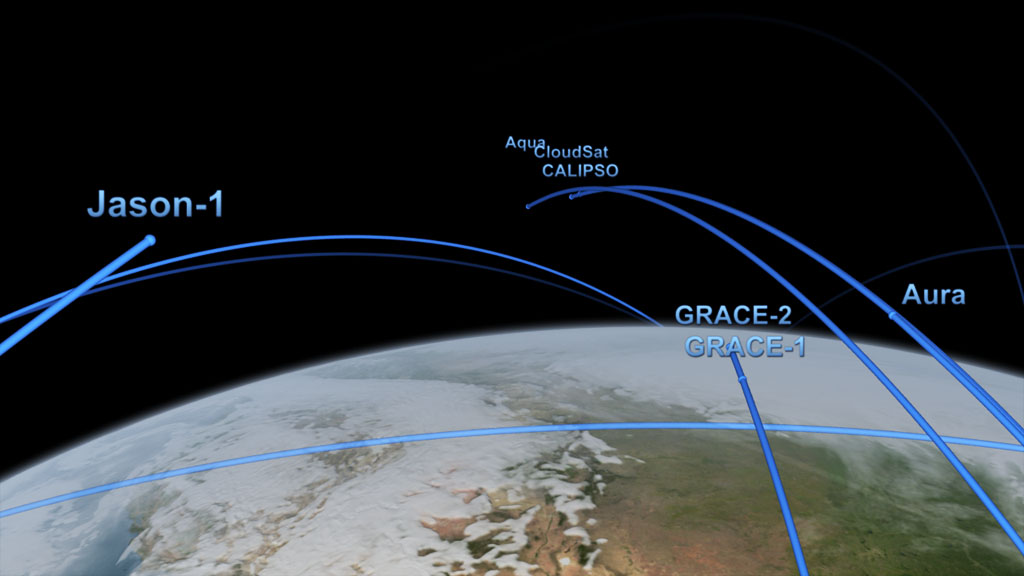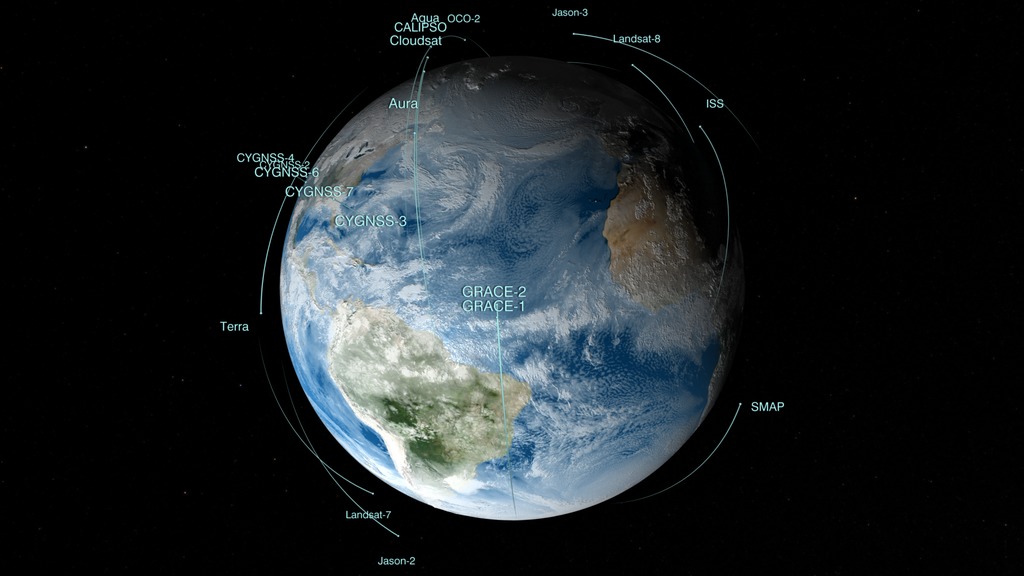A newer version of this visualization is available.
NCCS Hyperwall Show: Earth Observing Fleet with GEOS-5 Clouds
A newer version of this visualization can be found here.
This visualization is an update to a previous visualization of NASA's Earth observing fleet of spacecraft. Also incuded in this version are a couple of commercial spacecraft as well as the International Space Station and the Hubble Space Telescope. The spacecraft ephemerides are from February 2010.
The clouds are from a simulation using the Goddard Earth Observing System Model, Verison 5 (GEOS-5). The global atmospheric simulation ran at a resolution of 7-km per grid cell and covered a period from Feb 2, 2010 through Feb 22, 2010. The results of the simulation were written out at 30 minute intervals.
This visualization was created for display on the NASA Center for Climate Simulation (NCCS) hyperwall. This is a set of tiled high definition displays consisting of 5 displays across by 3 displays down. The full resolution of all combined displays is 6840 pixels across by 2304 pixels down. This movie was rendered at this high resolution, then diced up into images to be displayed on each screen.
Fully composited version of orbital fleet with GEOS-5 modeled clouds (all tiles together)

The large animation above is diced-up into smaller pieces that can be played on the hyperwall. Each piece is named according to a standard spreadsheet convention with a1 at the upper left and e3 at the lower right. This image illustrates this naming convention used in the diced-up frame sets below.
Display a1 of orbital fleet
Display a2 of orbital fleet
Display a3 of orbital fleet
Display b1 of orbital fleet
Display b2 of orbital fleet
Display b3 of orbital fleet
Display c1 of orbital fleet
Display c2 of orbital fleet
Display c3 of orbital fleet
Display d1 of orbital fleet
Display d2 of orbital fleet
Display d3 of orbital fleet
Display e1 of orbital fleet
Display e2 of orbital fleet
Display e3 of orbital fleet
Credits
Please give credit for this item to:
NASA/Goddard Space Flight Center Scientific Visualization Studio
-
Animators
- Greg Shirah (NASA/GSFC)
- Tom Bridgman (Global Science and Technology, Inc.)
- Ernie Wright (UMBC)
-
Producer
- Michelle Williams (UMBC)
-
Scientists
- William Putman (NASA/GSFC)
- Max J. Suarez (NASA/GSFC)
-
Project support
- Eric Sokolowsky (Global Science and Technology, Inc.)
Release date
This page was originally published on Friday, June 18, 2010.
This page was last updated on Tuesday, November 14, 2023 at 12:00 AM EST.
Missions
This visualization is related to the following missions:Series
This visualization can be found in the following series:Datasets used in this visualization
-
CelesTrak Spacecraft Orbit Ephemeris
ID: 454This dataset can be found at: http://celestrak.com
See all pages that use this dataset -
BMNG (Blue Marble: Next Generation) [Terra and Aqua: MODIS]
ID: 508Credit: The Blue Marble data is courtesy of Reto Stockli (NASA/GSFC).
This dataset can be found at: http://earthobservatory.nasa.gov/Newsroom/BlueMarble/
See all pages that use this dataset -
GEOS-5 Cubed-Sphere (GEOS-5 Atmospheric Model on the Cubed-Sphere)
ID: 663The model is the GEOS-5 atmospheric model on the cubed-sphere, run at 14-km global resolution for 30-days. GEOS-5 is described here http://gmao.gsfc.nasa.gov/systems/geos5/ and the cubed-sphere work is described here http://sivo.gsfc.nasa.gov/cubedsphere_overview.html.
See all pages that use this dataset
Note: While we identify the data sets used in these visualizations, we do not store any further details, nor the data sets themselves on our site.

